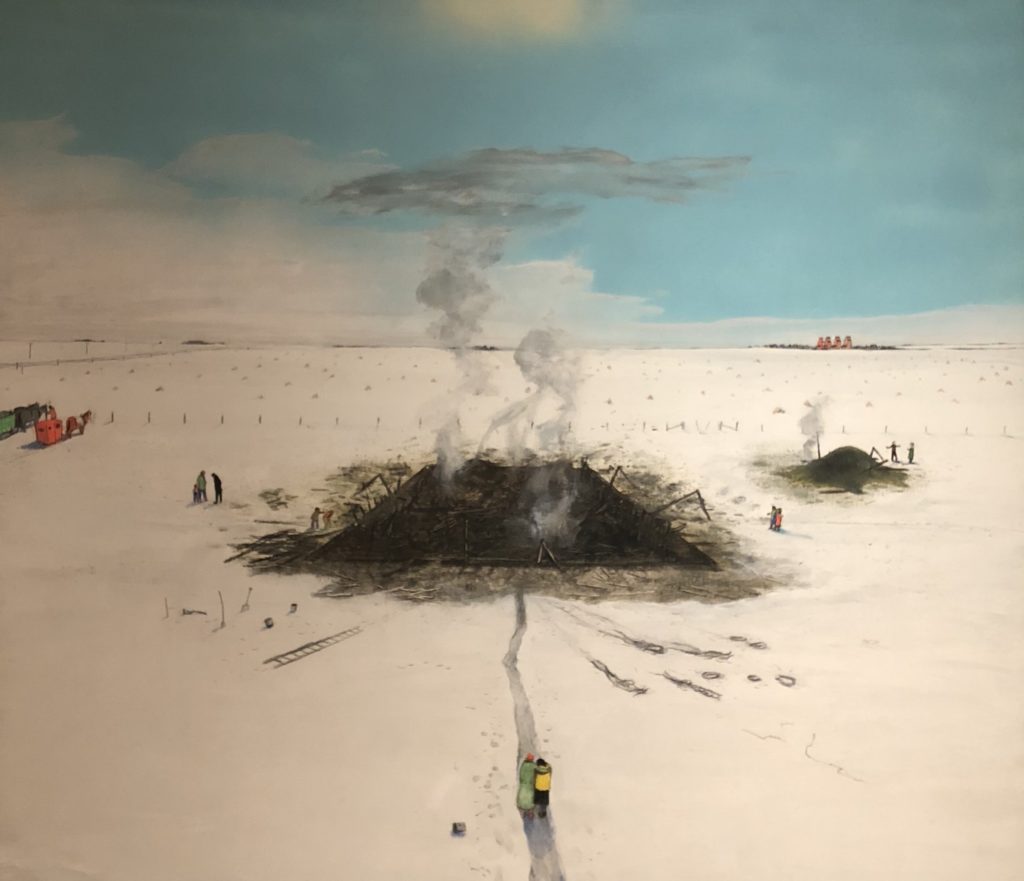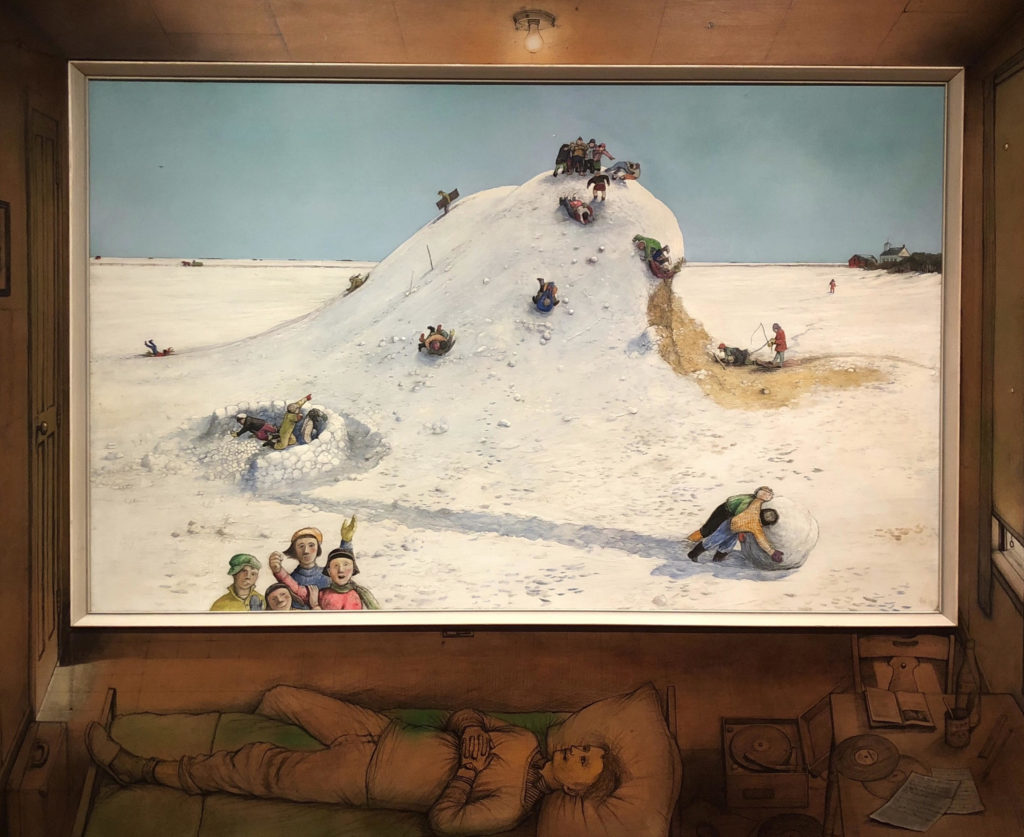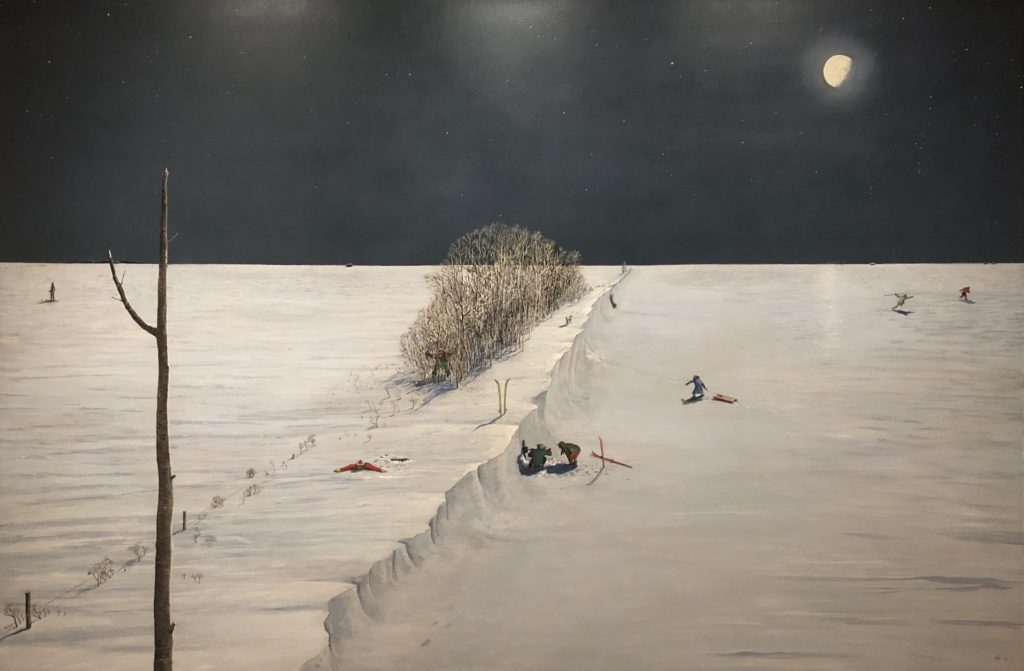When I was young I had a book titled ‘A Prairie Boy’s Winter and Summer’ by William Kurelek. With large print, simple text and full-page illustrations it ran through a year in the life of someone — a boy, I guess — living on the Canadian prairies: snowfalls, skiing behind tractors, farm labour, summer baseball games, the danger of a threshing machine…
I read it often as a child even though it left me with a vague sense of dissatisfaction, almost unease. I wanted the art to be more opulent and beautiful, or perhaps to convey a sense of arcane mystery, where instead it presented me with plain-featured figures bundled into brightly coloured, shape-erasing winter garb that looked suspiciously like the glamourless parkas and snow pants I had to don every winter. And at the same time I was quietly worried by the gap between my own life and the life I saw depicted on the pages — like the austere nature of the illustrations, the world they presented seemed hard and the delights so simple. I do not believe I would have possessed the vocabulary — or the refinement of thought — to articulate my feelings so plainly then, but I think I worried that the world this book presented was all the more ethically correct for being less indulgent, and that my alarm at it, my desire for the luxuries of my city-dwelling existence, marked me as in some way a fallen creature. I was a peculiar kid. I thought too much, even then.
What I did not know then was that William Kurelek was not just the author and illustrator of this book that vexed me but in fact a Canadian painter, someone whose art might hang on a gallery wall in addition to being reprinted in the picture book in my childhood hands. I only learned this years later, when I came across one of his paintings at the Art Gallery of Ontario. Oh, I thought, this looks familiar. What is it from?
The Kurelek paintings that hang in the AGO are darker and more complex than the simple illustrations I had in my book. In one, titled A Ukrainian Prairie Tragedy, small figures stand huddled together in front of a big dark brown square that takes up much of the centre of the canvas: the smouldering remains of their home. All around them is the white of snow, dotted with a few bright, almost neon, vehicles in the distance and a row of grain elevators. It looks, to my eye at least, almost toy-like until my gaze is drawn back to the centre of the canvas, the missing house. Two figures in the foreground face away from me, the viewer, and lean against one another, their grief their own business.
In another, Reminiscences of Youth, a winter prairie scene is enclosed by a thick wooden frame onto which Kurelek has painted himself, lying on a twin bed in a small room, and single bare lightbulb above his head. Kurelek studied framing in the UK, and constructed the frames for many of his paintings. Often they are decorated, but this one stands out for the blurring of frame and painting, now and then. The main painting becomes not just a scene but a memory self-consciously framed, which is to say — both highlighted and also constrained, limited. Children at the bottom of the image stare straight at you, inviting you in across a boundary you can’t cross — a boundary that even the painter cannot cross, lying in his tiny darkened bedroom and dreaming of all that space. I think it is interesting that the memory is in colour and real life in sepia tones. Which of these is more real? I cannot be the only one for whom the balance tips, sometimes, away from the present, towards the past.
The story of Kurelek’s adulthood, as I have read it, is that he left home early, as soon as he could, to free himself from an overbearing father and a harsh world that demanded mostly physical labour to survive; a place unsuited to the sensitive, artistic boy he was. And yet once free from this world he painted it again and again, and I am reminded of a poem by Seamus Heaney, ‘Like everybody else…’ where the speaker, describing their loss of faith, admits ‘and yet I cannot disavow words like “thanksgiving” or “host” or “communion bread.” They have an undying tremor and draw, like well water far down.’
Nostalgia folds back onto nostalgia. There is one painting in that room, Home on the Range, that reminds me of the uncomplicated book from my childhood: a clear-skies winter night lit by a bright gibbous moon, while in the snowdrifts on the ground a small number of brightly clothed figures are visible — some dragging sleds, one making his way through a snowdrift… I recall this painting often, it seems to have imprinted itself on my mind though I’ve only seen it a handful of times, perhaps through dint of being like what I already knew. Whose nostalgia, whose memory, is this?
I’ve never been certain who is speaking in ‘Like everybody else…’. The epigraph reads ‘in memory of Czeslaw Milosz’ and the text of the poem itself is printed within single quotation marks, as though Heaney were quoting someone, possibly Milosz. Yet there is no note in the Acknowledgements that this might be the case, no source given. Perhaps it was a conversation that happened once between the two of them, spoken prose reworked into written verse, Heaney’s recollection of Milosz blurring into Milosz’s recollection from his own life. We’re all looking backwards. Memory folds onto memory.
The other night I was walking home through the snow and found myself face to face with a perfect Kurelek scene; young men on a field of snow, clad in bright and clashing colours. It had snowed suddenly, unseasonably early, and they were out playing soccer by the university. I stood there and watched them, the white field, their cartoon-like figures standing out in stark relief. Oh, I thought, this is familiar. I thought of that Kurelek painting, and I thought of myself as a young girl reading through the prairie seasons, the light from our living room windows falling onto the pages in front of me, the fascination and the unease, and for a moment all these memories glowed brighter than the scene in front of me. This undying tremor or draw, like well water far down. Something caught in my throat and I didn’t know what else to do, so I took a photo of it, went home and wrote this. One more attempt to cast a line between where I was once, and where I am now, the edges of the frame blurring, if just for a moment.
//
All photos of Kurelek paintings were taken at the Art Gallery of Ontario. ‘Like everybody else…’ by Seamus Heaney is included in District and Circle, published in 2006 by Faber & Faber.





4 comments for “Like everybody else…”